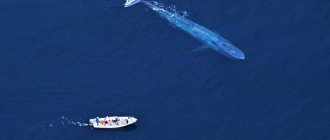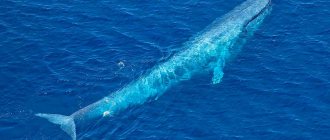Difference between Orca and Dolphin
The main difference between killer whales and dolphins is that the Killer Whale is the largest member of the dolphin family , while the Dolphin is an aquatic mammal belonging to the order Cetacean. Moreover, the killer whale is considered one of the largest predators in the world.
Dolphins are aquatic mammals and belong to the cetacean group of mammals. They are carnivores and feed on other marine animals such as seals, fish, whales, crustaceans, etc. In addition, dolphins are classified as chordates. They are one of the most intelligent animals and they often exhibit playful behavior.
Content
Relationship with a person
In 1982, the capture of killer whales was prohibited by law. But this ban does not apply to their catch for scientific research. Under natural conditions, the mammal does not show fear of people. If a person does not try to harm, it does not attack, so no such cases have been recorded.
The relationship between killer whales and humans when keeping animals in captivity is somewhat different. They often become aggressive and can attack the trainer. There was a recorded case where the attack led to death. Keeping killer whales in captivity is now prohibited because it reduces their life expectancy by almost half.
Several years ago, killer whales were used for display in various shows, but their training is extremely difficult and the danger is high. Animals become irritable, refuse food, lose weight, and can attack not only humans, but also their fellow animals.
Who is Orca?
The killer whale is the largest representative of the dolphin family. Killer whales are toothy representatives of the dolphin family, which belong to the order Cetaceans. Killer whales have a varied diet, but they hunt large prey. Some feed on fish, while others hunt various marine mammals such as dolphins and seals.
Moreover, the killer whale is considered one of the largest predators in the world. The scientific name of the killer whale is Orcinus orca. Additionally, they are a cosmopolitan species that live in a variety of marine environments in the world's oceans. Based on their place of residence, survivors are divided into three types: resident, transit and vagrant. They come in black and white and range in length from 7 to 10 meters and weigh up to 6 tons. Additionally, they have an average lifespan of 50 to 80 years.
Behavior
Killer whales have a complex social structure. They travel in groups (flocks) that can contain up to 50 individuals. There have even been reports of hundreds of killer whales in one group, but this was a temporary association between small groups. Individuals in flocks typically represent several generations of relatives and consist of about 20% mature males, 20% young, 60% females and immature young. Individuals in schools swim within 100 meters of each other and coordinate their activities. They may share prey and rarely leave their group for more than a few hours. Adult killer whales teach the younger generation all important life skills.
Who is Dolphin?
The dolphin is an aquatic mammal. Dolphins are a diverse group of aquatic animals widely distributed throughout the world. These marine mammals are very smart. Some dolphins have teeth and fall under the category of toothed dolphins. The sedge is one of the representatives of the suborder of toothed dolphins. They are carnivores and feed on marine organisms such as fish, seals, crustaceans, whales, etc. They are mostly gray in color.
Around the world, the preferred habitat of most dolphin species is shallow waters in tropical and temperate oceans. However, some species live in rivers. Moreover, dolphins exhibit playful behavior. They jump out of the water and watch and follow ships. Dolphins differ from porpoises in their heads, teeth, fins and shapes. But both groups are similar.
What is the difference between an Orca and a Dolphin?
The killer whale and the dolphin are two aquatic mammals. The killer whale is the world's largest dolphin. The color of killer whales is black and white, while most dolphins have gray skin.
Conclusion
Dolphins are aquatic mammals. Killer whales are the largest species of dolphins. Dolphins belong to the suborder toothed whales. All dolphins belong to the order Cetaceans, but not all cetaceans are dolphins. Most dolphins live in shallow waters in tropical and temperate oceans around the world. Some species also live in rivers. This is the difference between an orca and a dolphin.
You may also like
Commercial value
Back in 1982, fishing for killer whales was banned after a special moratorium was introduced. The purpose of the moratorium is to protect such marine inhabitants in order to stop the process of decline in the number of killer whales and, as a result, to protect these predators from further extinction. Despite this, some peoples living in northern latitudes still continue to hunt killer whales and other cetaceans. Unfortunately, it is not possible to completely stop this process, since people need to somehow survive in such difficult conditions. In addition, killer whales are captured for scientific purposes, as well as for keeping in captivity.
Important to remember! Keeping killer whales in captivity is a highly controversial issue in our time. Being in the natural environment, these marine predators do not show aggression towards humans. Once an orca is in captivity, humans become its main enemy, while they are not so aggressive towards other inhabitants of the deep waters who have suffered the same fate. In addition, keeping orcas in captivity is not comfortable, and their life expectancy becomes almost 3 times shorter.
If we compare other inhabitants of the seas and oceans with killer whales, then their life expectancy in oceanarium conditions, on the contrary, becomes longer. Most likely, this is due to the fact that in captivity they have practically no natural enemies, and there is enough food.
What's the difference between dolphins and killer whales?
The killer whale is the largest representative of the dolphin family. Its strong body weighs from 2.5 to 9 tons with a length of about 7 m, a huge dorsal fin, which in the oldest males reaches 1.8 m, a characteristic shine of black livery with spots - white at the eyes and on the sides and gray behind the dorsal fin — make the killer whale so easily recognizable that it is simply impossible to confuse it with anyone else. The pectoral fins also have a special rounded shape and grow throughout their lives. There are obvious differences between representatives of both sexes: firstly, the shape and height of the dorsal fin, and secondly, the size of the animal itself - the female is three meters shorter than the male. It is not uncommon to find a solitary killer whale, but groups of killer whales, numbering from 5 to 20 individuals connected by strong family ties, are much more typical. Two or three of these clans may unite and form a larger pack, a veritable clan of about 50 members. Individuals of the same genus are connected with each other for life; the clan even develops its own dialect. Killer whales communicate with sharp screams and ultrasounds, which inspire fear in all other mammals, including large cetaceans, who prefer to stay away. The killer whale's menu is more varied than the diet of other cetaceans. It includes squid, fish, birds, sea turtles, seals, and dolphins. Killer whales even attack such large animals as the blue whale. Often several clans unite during the hunt and try to focus on one, completely ignoring all other potential prey. When a killer whale's mouth closes, the inward-curved teeth close tightly together. Contrary to popular belief, killer whales never attack humans, and skirmishes within the pack are extremely rare. They reach speeds of up to 55 km per hour and perform the entire range of routines common to cetaceans: they jump, hit the water with their fins and slowly dive so that at first only the head and pectoral fins remain on the surface, and then suddenly they suddenly go completely under water. It is very difficult to raise a killer whale in captivity due to the fact that it eats at least 50 kg of fresh fish every day, although it will not be difficult to tame this smart animal, like all dolphins. Killer whales are cosmopolitan: they are found in all seas, but more often they can be found in cold waters. This animal prefers great depths, but also swims into small bays, inland seas and estuaries. The killer whale easily makes its way between drifting ice in search of prey. Never making long migrations, it only moves within a small radius from place to place.
Christina! You treated me with this news in a big way. The whole world has been turned upside down. And how have I lived until now? In the dark, no less. Thank you for enlightening the ignoramus. Opened our eyes to the truth. ))))) Don't be offended by my jokes, okay?
Who are they, killer whales? This is not a whale at all, as some people believe. Killer whales are the largest dolphins. All killer whales are divided into 3 genera - large, black and feresa. The most bloodthirsty is the big killer whale.
I guessed that I haven’t liked his face for a long time))))))))))))) now let him just try to join us when the privateer gives us a tasty treat
killer whale is a large dolphin which are divided into three genera: large black and feresa, the most bloodthirsty of them is large killer whale
In English, killer whale is translated as “killer whale,” but in fact, killer whales are the largest carnivorous dolphins. Of course I knew)
Maybe. We know almost nothing about creation - only grains. And through viewing and studying creation we see the Creator!
A killer whale is a whale, and very dangerous like a shark. Well, if he tames it, he will be more or less obedient, but not like dolphins.
Not certainly in that way. Dolphin family. And the order of cetaceans. But in one word, then a dolphin, of course.
Actually, a killer whale is a bird. And a killer whale is a cetacean mammal, and yes, I knew about the dolphin)
Killer whales are the largest dolphins. All killer whales are divided into 3 genera - large, black and feresa.
No! far from me! there is an aquarium but more like a still life part of nature and not a subject of study
I know more about them. you can't tell me the exact number of shark species. otherwise I'll be amazed
I know. There was also a movie called Flipper, about a trained dolphin. That’s where I found out
The killer whale is a bird from the swallow family. and a killer whale. it's from the dolphin family
Source
Interesting Facts
- Killer whales have a social status similar to our “grandmother”. Old females, no longer capable of reproducing offspring, raise young animals, teaching them the wisdom of life: they hammer into the “youngsters” the basics of hunting tactics, migration routes, and fairway locations. Yes, there is a lot of things that need to be “told” to the young while the middle generation is on the hunt.
- The killer whale is considered one of the most compassionate creatures. Not only do young individuals take care of the elderly, help the sick and wounded, but they also share the prey they bring among the entire group. That is, little by little, but there should be enough for everyone!
- Before entering an unknown place to hunt, killer whales “sonicate” it and conduct ultrasound sonar. They must understand whether their large bodies will be able to maneuver off an unknown coast.
- When hunting, they are extremely inventive; they have their own approach to each victim. You can “run” after someone for a longer time across the expanses of the sea, apparently enjoying the walk, but for someone it is better to attack with a “ram”. Over millions of years, these animals’ skulls have become so strong that they can afford such a maneuver. It's amazing that they anatomically accurately guess the weak point of the unfortunate - gills, head or stomach.
- Interestingly, there is also a fish called “killer whale” from the killer whale family of the catfish order. It is also called “squeaky” due to the fact that when caught from the water, it makes loud creaking sounds.
Sources
- https://wildfauna.ru/kosatka
- https://zoolog.guru/morskie-obitateli/kasatka-eto-delfin-ili-kit-chem-pitaetsya-zhivotnoe-ego-foto.html
- https://4lapki.com/2018/12/mesta-obitaniya-kosatki
- https://NatWorld.info/zhivotnye/kosatka-opisanie-sreda-obitanija-razmnozhenie-povedenie-pitanie-i-ugrozy
- https://givnost.ru/kasatka-kit-opisanie-osobennosti-vidy-obraz-zhizni-i-sreda-obitaniya-kasatki/
- https://faunistics.com/kosatka/
[collapse]
How a killer whale got caught in fishing nets
@ Aktim pixabay.com
The life of a young killer whale was saved. The fishermen received a worthy reward and brought their catch to a small fenced bay. The male will receive a name - Namu. For several days, the individual behaved warily, was stressed, and even refused to eat. Scientists lost heart and began to think that the killer whale, like the freedom-loving white shark, cannot live in limited tanks.
To save Namu, scientists shot him with a bow and special arrows, the tips of which contained vitamins required to maintain the life of the individual. It was possible to restore her appetite, and the killer whale began to eat its normal amount of 200 kg of fish per day.
Ichthyologist Edward Griffin made a bold decision and dared to tame the killer whale. Every day he came closer and closer to the net, but the young whale ignored him in every possible way: he simply swam in the other direction or did not pay attention. The researcher was glad that Namu was not aggressive. In addition, the killer whale understood that it was the person who was giving her the fish. Over time, the ichthyologist managed to find out that Namu loves red fish. This became the basis of friendship.
@ nightowl pixabay.com
Just six months later, the researcher decided to jump into the water of the pen, despite the fact that his colleagues tried in every possible way to dissuade him. Edward Griffin became very attached to the orca and believed in its good character. Surprisingly, he was not mistaken.
As soon as the ichthyologist was in the water, Namu approached him. Griffin noticed genuine curiosity and friendliness in the huge eyes of the predatory mammal. He said that his look reminded him of a peace-loving dolphin. The man boldly walked towards Nam and scratched his head with a brush.
From that moment on, the true friendship between man and killer whale began. Griffin himself fed his charge every day, scratched him with a brush, and once even climbed onto the back of a huge mammal.
Not everything was so smooth. One day, while feeding, a researcher's leg fell into Nam's mouth. This moment could be considered critical, but the killer whale did not intend to cause any harm to the person. At this moment, all the fears the researcher had dissolved. He was ready to experiment further.
Namu has fully adapted to the new conditions. He began to swim to the call of the breadwinner, responded to his name and with extreme caution learned to take fish from a person’s hands.
Habitat
Killer whales are found in all oceans from the Arctic to the Antarctic, and they go far into floating ice. They like to swim offshore, although they can be seen close to land while hunting seals and penguins. Their habitat is the seas and oceans of the entire planet. They usually swim at great depths, but sometimes they can swim into river mouths . They prefer cold seas and oceans, so they are most often found in cold and temperate waters. They appear extremely rarely in the tropics.
They hunt in packs and live in groups. Matriarchy reigns in their environment, despite the fact that males are much larger than females. During the hunt, females with cubs are kept at a safe distance, but can take part if there are few males. It is always peaceful and calm in a group of killer whales. Often groups can come together to successfully go on a hunt.
Researcher's findings
Edward Griffin made an unexpected conclusion. He said that killer whales are much smarter than dolphins and it was with them that we had to work initially. If a person had acquired such a strong sea friend earlier, he would have already explored the ocean far and wide. In intelligence, killer whales are absolutely not inferior to their relatives and even surpass them.
Killer whales have another, more significant advantage over dolphins. The most important thing is outstanding physical abilities. Huge black and white dolphins can dive to great depths and develop considerable speed.
@ Pexels pixabay.com
The dolphin can be given only one small device for research. The killer whale, due to its size, can carry a real laboratory on its back.
That's right, in the midst of studying the brains of dolphins, they had a rival. Today it is difficult to say who scientists will use to study the depths of the World Ocean in the future. What do you think, can the killer whale become a “colleague” of ichthyologists? Leave your answers in the comments. Don't forget to subscribe to our channel and share links to publications with your friends. Only for you – the most interesting things are ahead.
Source
Can't smell
Killer whales do not have olfactory organs or a lobe of the brain dedicated to detecting smells. But they have good eyesight and hearing. They hear better than dogs and even bats. Using excellent auditory perception, they practice echolocation. This means that killer whales make sounds and then listen for echoes. This way they can accurately determine how far away objects or other animals are from them.
killer whale
Killer whale - there have been legends about this thunderstorm of the oceans since ancient times. The old “sea wolves”, salted by the ocean winds, will tell you many bloody stories.
However, where is truth and where is fiction, we will leave it to the conscience of the storytellers. We will turn to trusted sources.
The killer whale is a marine mammal with a contrasting color, reaches a length of 10 meters and weighs up to 8 tons. But what kind of killer whale is she - a whale or a dolphin, or maybe even a shark?
Kinds
Two more specimens can be classified as killer whales:
- The black killer whale, or lesser killer whale, is also called the false killer whale because of its completely black color. It is inferior in size to the ordinary one, as it grows up to 6 m in length and weighs about a ton and a half. She is much more thermophilic than her relative, and has chosen temperate and subtropical waters for her habitat.
- Feresa is a small pygmy killer whale. She has grown only to 2 meters, feeds on small fish and tries not to catch the eye of humans. Painted dark grey.
About 6-7 years ago, an interesting character appeared on the Internet - a white killer whale named Iceberg. It was filmed twice near the Commander Islands. The video was accompanied by a comment that from 2008 to 2015, five such killer whales were spotted in the Russian part of the Pacific Ocean. However, it has been established that this is not a new species of animal, but an albino. Most likely, the white color has become an alarming indicator of an unsuitable environment.
Description and features
Killer whales live over vast areas from Alaska to Antarctica and from Argentina to Iceland. But they especially loved the coastal waters of the Aleutian Islands, coastal areas of Alaska, the northern Pacific Ocean and the southern Bering Sea. In the open ocean, killer whales may pose a threat, but in captivity such violent aggression is not observed from them.
Although when such a “fish” swims near the surface, its dorsal fin rises more than two meters above the water. The spectacle, frankly speaking, is not for the faint of heart. But the whole intrigue lies in the fact that the killer whale is not a whale at all, although it belongs to the order of cetaceans and the suborder of toothed whales, and even more so, the killer whale is not a shark.
Whale or dolphin?
A killer whale is a dolphin. Yes, yes, exactly a dolphin, only a very large one, and to be completely precise, an aquatic mammal of the suborder of toothed whales, the dolphin family. Maybe that’s why we see killer whales in oceanariums as very peaceful and obedient animals?
But in the wild, she is a formidable and merciless predator. The killer whale hunts not only fish and squid, but even sharks. She will not spare the seal, the penguin and her fellow dolphin. There are cases that it attacks the huge baleen whales themselves. Having noticed prey on an ice floe - a penguin or a seal, they launch a very clever attack: from below, they simply break the ice floe with a monstrous head blow. But all this applies to the big killer whale. There are also black killer whales and the so-called feresa.
Reproduction
Puberty in males begins at 8 years of age, and in females 2 years earlier. The mating season occurs from the beginning of winter. Scientists have collected little information about killer whale mating. It is known that during the mating season, males are very aggressive and fight fiercely for the right to mate. Cubs are born in spring or early summer, and a female can have only 1 cub. The playful baby weighs only 260 kg and is 2.1 -2.7 meters long. The mother feeds the baby with her milk until the age of 1 year. She will be ready for the next mating only after 3-4 years.
Killer whales are considered very smart animals. They are very trainable . When they end up in aquariums or dolphinariums, under these conditions they perform the most difficult tricks. There are acts where the trainer puts his head in the killer whale’s mouth, and the predator carries the trainer on its back in front of the audience during the show. When they have to live in captivity, they behave differently. Aggressive and menacing animals become favorites of the public because they are peaceful and do not pose a threat.
Which is correct - killer whale or orca?
In fact, few people can immediately answer the question of how to spell it correctly: killer whale or orca. And it's not just a matter of pronunciation. Traditionally, the word “killer whale” is used in spoken language, but this is not correct. That's right - killer whale, since the very name of this animal was formed because the dorsal fin of males in its outline resembles a scythe, and the animal itself, alas, has long earned its reputation as a killer whale. But in colloquial speech, people usually use the word “killer whale.”











